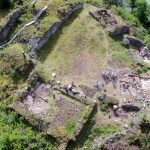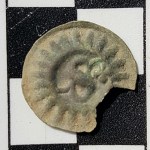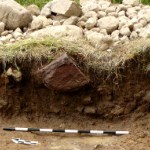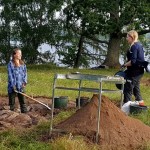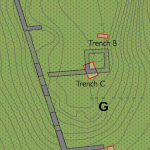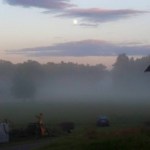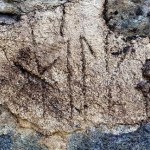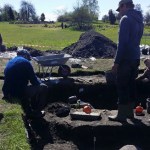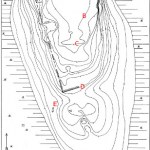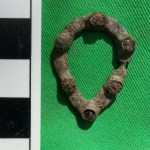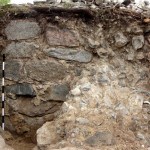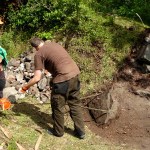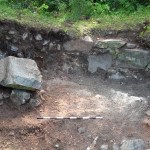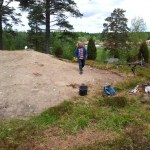fieldwork
Our second week at Skällvik Castle proved a continued small-finds bonanza, and we also documented some pretty interesting stratigraphy.
More of everything in Building IV. In addition to more coins of Magnus Eriksson, dice and stoneware drinking vessels, we also found a lot of points for crossbow bolts. It's starting to look like the castle guards' day room! As for why we found crossbow bolts only inside one building and none outdoors in the bailey, I figure that they had been amassed there for re-fletching. The dark indoors find context and the undamaged sharp points show that the bolts did…
The famous royal castle of Stegeborg sits on its island like a cork in the bottleneck of the Slätbaken inlet (see map here). This waterway leads straight to Söderköping, a major Medieval town, and to the mouth of River Storån which would allow an invader to penetrate far into Östergötland Province's plains belt. The area's first big piece of public construction was 9th century fortifications intended to guard this entrypoint, in the shape of the Götavirke earthen rampart some ways inland and a wooden barrage at Stegeborg. This barrage was kept up for centuries, and indeed, the castle's name…
We spent Thursday afternoon backfilling. As I write this, only trench G remains open, and the guys there expect to finish soon. Here's some highlights of what we've learned during our second week at Birgittas udde.
Trench A in the outer moat demonstrated that the moat had a wide flat bottom, was not very deep and contains no lake sediments. Probably always a dry moat, providing material for the bank behind it. No Medieval finds.
Trench C: section through the deep inner moat.
Trench C in the inner moat demonstrated that this moat too had a wide flat bottom, but it was deeper and is full of…
Ulvåsa in Ekebyborna is a manor near Motala with two known major Medieval elite settlement sites. Excavations in 2002 proved that the unfortified Gamlegården site was established before AD 1100. The fortified Birgittas udde site has seen no archaeological fieldwork since 1924, when the main building's cellar was emptied and restored. Its date is only known to the extent that almost all moated sites of this kind in Sweden belong to the period 1250-1500. My current book project deals with Östergötland province's fortified sites of the High/Late Middle Ages, and so I decided to spend two weeks…
Myself, Ethan Aines and Mats G. Eriksson are proud to present our report on last year’s fieldwork at Stensö Castle, Östra Husby parish, Östergötland. Lots of goodies there, and with an added meaty report on the bones by Rudolf Gustavsson! It was a very fruitful two weeks at the site, during which we found the missing half of the perimeter wall, abundant fine pottery from around AD 1300, a runic inscription by a certain Helgi, the bones of a skinned cat, and more.
Here on Sb: Stenso 2015 Report (High-res, single-sided print)
And on archive.org.
See also the report for…
2014 trenches A-E and rough locations of 2015 trenches F-H.
I write these lines on the day after we backfilled the last two trenches at Landsjö, packed up our stuff, cleaned the manor house, hugged each other and went our separate ways. It's an odd feeling to take apart the excavation machine while it still runs. It's been four fun and successful weeks!
Since my previous entry, written on Monday evening, we've done only three days of further excavation. Our main findings, to the extent that I have any comprehensive overview of them at the moment, relate to the culture layers sitting…
2014 trenches A-E and rough locations of 2015 trenches F-H.
Like Stensö, Landsjö Castle has half of a rare perimeter wall and is known to have been owned by a descendant of Folke Jarl – or rather, by his daughter-in-law, the widow of such a descendant. Last year we found that the high inner bailey has a previously unseen southern wall with a square tower at the east end, and we found five coins of AD 1250-75 in a deep layer that seem likely to date the castle's construction phase. But unlike Stensö, in three strategically placed trenches we found no trace of the missing bits of the…
Balancing available labour and a pre-decided excavation agenda against each other is not easy, particularly when you're doing investigative peek-hole fieldwork on a site whose depth and complexity of stratification you don't know much about. At Stensö we had two of three trenches and all five test pits backfilled in time for Wednesday lunch's on-site hot dog barbecue. Ethan Aines, Terese Liberg and three students stayed on to finish trench F, while myself, Mats Eriksson and six students moved to our new base at Landsjö Manor.
Trenches D and E and the test pits produced no big news after my…
This year's first week of fieldwork at Stensö Castle went exceptionally well, even though I drove a camper van belonging to a team member into a ditch. We're a team of thirteen, four of whom took part in last year's fieldwork at the site. All except me and co-director Ethan Aines are Umeå archaeology students. We're excavating the ruin of a castle that flourished in the 13th and 14th centuries. This year we have a very nice base at Smedstad, let to us by the genial B&B host Hans-Ola. But we cook our own meals, each day having its designated cooks and dishwashers, and in the evenings we…
When I tell people I'm an archaeologist, they often ask ”So have you dug at Birka?”. As of yesterday I can finally proudly reply ”yeah, a bit”.
”Birka” is a Latinate attempt to write Biærkey, ”Birch Island”. It's an island in Lake Mälaren, two hours by slow boat from Stockholm. For a bit more than 200 years starting in the mid-8th century, it hosted the first town on Swedish soil, established there as a regulated international trading post under the protective (and probably tax-grabbing) hand of the Kings of the Swedes. This immortally classic Viking Period site has huge cemeteries, a huge…
Having read yesterday's entry about what I need to get hold of before I can dig a site, Apel Mjausson asked me on Facebook, "How do you decide where to dig? Sweden is lousy with unexplored sites. Are you following a specific story, looking at place names, take nominations...?"
Disregarding sites I've been paid to dig and sites I've only metal-detected,* my motivations have been as follows. To begin with, I only ever dig sites that I judge likely to produce something publishable and exciting. (And sometimes I lose on that gamble).
At Barshalder in 1997 I dug two graves because at my advisor's…
I've headed my own research excavations since 1996. Now I'm preparing for four weeks of fieldwork during the upcoming season. I operate as an independent scholar in this context, and none of my excavations have been prompted by land development. Here's what I need to get hold of before I can break the turf or metal-detect the plough soil on an archaeological site in Sweden.
Contacts/notoriety. I couldn't get much of what's listed below without contacts/notoriety in the business.
Funding. Most of my research money comes from small private foundations in annual instalments of about $3,600 (€3,…
Christian Loven's plan of Landsjö Islet with letters marking on-going fieldwork.
Landsjö castle is on a high islet in the lake next to the modern manor house. Nobody ever goes there. The ruins are covered by vegetation and they're in bad shape: only along the western side of the islet do they rise even a metre above the rubble and accumulated forest mulch. Visible is a 59-metre N-S stretch of perimeter wall with a preserved corner at either end, and a shorter W-E stretch of perimeter wall from the south-western corner. Along the inside of the visible wall are vague suggestions of two…
With two days of digging and one day of backfilling left at Stensö Castle, trenches A and B have already given a rich harvest of new information.
The northern tower was a green ruin mound when we came to site. We now know that the tower was built entirely of greystone, it was round with a diameter of about 5.5 m, and it was planned and built together with the perimeter wall. The lost western half of the latter did not join the tower on a radial line. Instead more than half of the tower's circumference was outside of the perimeter wall, allowing flanking, where bowmen in the tower could strafe…
After four days of rubble removal in trench A, we found the south wall of Stensö Castle's northern tower. Note how the wall facing (left) ends, and a pale mass of wall core (lower right) emerges out of the tower. This is the castle's previously unseen western perimeter wall.
Our first week of two at Stensö is over, and already Chris, Fanny and Simon have made trench A answer the question we've asked of it. Way back in line with the trench's top edge on the flank of the northern tower's ruin mound, they've uncovered a neat wall face of dressed ashlar, and out of this tower wall projects an…
Medieval walls are usually shell walls, where you construct an inner and outer shell of finely fitted masonry while filling the space between them with a jumble of smaller stones and mortar. Usually the facing stones don't project much into the core. When the wall is allowed to erode, once the cap stones have fallen off, the facing starts to peel from the core one ashlar or brick at a time from the top down. Before the resulting rubble layer's top (rising) reaches the level of the wall's eroding top (descending), halting erosion, you'll see a ruinous wall that is thick and smooth-faced in its…
Stensö castle, trench C, the part along the perimeter wall. Note the ashlar.
Drove down to Vikbolandet on Sunday night with my excellent colleague Ethan Aines from Stanford, and we were met at expedition HQ by seven of my Umeå students from last autumn semester. Very pleased to see them again! They've just finished their second term and several are scheduled to go on to the third. So I'll be seeing them in the halls in September when I take on my second batch of Umeå freshmen, and if I'm lucky I'll get to supervise a few of them for their BA theses. Everyone's being charming and nobody…
It's Sunday morning and I'm getting ready for four weeks of excavations. I haven't done any digging since the Pukberget cave dig in 2011, and my last multi-week dig with a big team was at Sättuna in 2008. So it's high time, and I'm excited. Getting stuff from my study, packing stuff at home, buying some extra tools and a lot of food.
My crew of ten will be assembling at a farm-labourers' dorm in Östra Husby starting tonight, and tomorrow we break turf at Stensö castle ruin as the first archaeologists to dig there. Most team members are first-year students from Umeå whom I taught during the…
People who do a lot of field work end up with interesting stories to tell, especially if the fieldwork is diverse and the conditions are adverse. Often, the sort of thing people want to know about is very different from the repertoire of available stories, but as long as the expectations of the audience is not too rigid, experienced fieldworkers in the various sciences that do field work make the best cocktail party extras.
I never met Jon Kalb, but we have a lot of colleagues in common. I first heard of him as one of the scientists on the same expedition that found the famous fossil "Lucy…
Spent the day digging with my friends Mattias Pettersson and Roger Wikell like so many times before. I like to join them on their sites for a day every now and then (2007, 2008, 2010). The two are mainly known as Mesolithic scholars, but I have been with them on a Neolithic and a Bronze Age site as well on previous occasions. And this time they're straight up my own alley of research: they're digging the largest of the Viking Period burial mounds in Tyresta hamlet's southern cemetery. Measuring eleven meters in diameter and about one-and-a-half in height, it's a pretty imposing structure…
